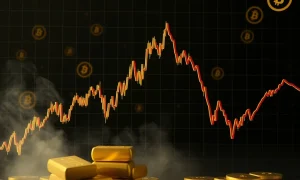Investors closely monitor market shifts, especially those impacting traditional safe-haven assets. Recently, the gold price experienced its most significant single-day decline in three months. This sharp tumble followed widespread reports that the United States government intends to clarify its tariff plans concerning bullion. This news immediately sent ripples through global financial markets, causing a notable reaction among precious metals traders and long-term investors alike. Consequently, understanding the underlying reasons and potential future implications of this market movement is crucial for anyone involved in finance or investment.
Understanding the Gold Price Reaction to Tariff News
The recent dramatic drop in the gold price highlights the intricate relationship between geopolitical events, economic policy, and commodity markets. Specifically, the prospect of the U.S. government providing clear details on its tariff strategy regarding bullion introduced a new layer of uncertainty, ironically leading to a reduction in the perceived need for gold as a hedge. Typically, gold thrives on ambiguity and fear. When markets face economic instability or political tension, investors often flock to gold, viewing it as a reliable store of value. Therefore, any news that either increases or decreases this uncertainty directly impacts gold’s appeal.
Reports suggested that the U.S. might clarify whether specific forms of gold imports would face new tariffs. This potential clarification, even if it implied tariffs, could remove a layer of speculation that had previously supported gold. Uncertainty often drives the price of safe-haven assets higher. When that uncertainty begins to dissipate, even if the resolution is not entirely positive, the immediate demand for these assets can wane. This is precisely what market observers witnessed.
The Role of Tariffs in Global Trade and Gold Price Dynamics
Tariffs are essentially taxes imposed on imported goods and services. Governments use them for various reasons, including protecting domestic industries, generating revenue, or as leverage in international trade negotiations. Historically, tariffs have often been a source of global trade disputes. When countries impose tariffs, it can lead to retaliatory measures, escalating into trade wars. Such conflicts invariably create economic uncertainty, which in turn typically boosts the appeal of safe-haven assets like gold.
However, the current situation presents a nuanced scenario for the gold price. Instead of new tariffs being imposed without warning, the market reacted to the *clarification* of existing or potential tariff plans. This distinction is vital. Consider these points:
- Uncertainty Reduction: A clear policy, even if unfavorable, is often preferred over ambiguous speculation. Market participants can better price in known risks.
- Dollar Strength: Tariff discussions can influence currency markets. If clarity strengthens the U.S. dollar, gold, which is priced in dollars, can become more expensive for international buyers, reducing demand.
- Inflation Expectations: Tariffs can contribute to inflation by increasing import costs. However, if the market perceives that tariff clarity might stabilize trade relations, inflationary pressures might be seen as less immediate, impacting gold’s role as an inflation hedge.
Moreover, the news suggested that the U.S. might be looking to define its stance on bullion imports more precisely. This could be part of a broader strategy to manage trade balances or address specific concerns related to commodity flows. The immediate market response indicates that investors interpreted this clarification as reducing the need for gold as a crisis hedge, at least temporarily.
Market Reaction and Broader Economic Implications for Gold Price
The day the news broke, the gold price saw its sharpest one-day decline in approximately three months. This significant movement underscores how sensitive the precious metals market is to policy signals from major economies. Volume on futures exchanges reportedly surged as traders adjusted their positions rapidly. This indicates a strong conviction among market participants that the news warranted a significant re-evaluation of gold’s short-term trajectory. Many analysts quickly pointed out that the move was less about a fundamental shift in gold’s long-term value and more about a recalibration of risk premiums associated with trade policy uncertainty.
Furthermore, the reaction was not isolated to gold. Other safe-haven assets, such as government bonds, also experienced some adjustments, albeit less dramatic. This suggests a broader sentiment shift in the market, where investors began to unwind positions that had been built up in anticipation of prolonged trade tensions and economic ambiguity. The U.S. dollar, conversely, showed signs of strength, which typically exerts downward pressure on gold prices, as a stronger dollar makes dollar-denominated assets more expensive for holders of other currencies.
This market reaction also reflects a broader economic implication: the market’s craving for certainty. Businesses and investors prefer a clear regulatory and trade environment. Even if the clarity involves potential tariffs, having a defined framework allows for better planning and risk assessment. This reduces the ‘unknown unknowns’ that often fuel demand for gold as an ultimate hedge.
Analyzing the Factors Influencing Gold Price Beyond Tariffs
While the tariff news was the immediate catalyst for the recent tumble, it is crucial to remember that the gold price is influenced by a multitude of factors. Tariffs are just one piece of a complex puzzle. Understanding these other drivers provides a more comprehensive view of gold’s market behavior:
- Interest Rates: Higher interest rates make non-yielding assets like gold less attractive compared to interest-bearing investments.
- Inflation: Gold is often seen as a hedge against inflation. If inflation expectations rise, gold typically benefits.
- U.S. Dollar Strength: As gold is priced in U.S. dollars, a stronger dollar generally makes gold more expensive for international buyers, reducing demand.
- Geopolitical Stability: Political unrest, wars, or major international crises tend to boost gold’s appeal as a safe haven.
- Central Bank Policies: Monetary policies, including quantitative easing or tightening, significantly impact liquidity and investor sentiment, influencing gold.
- Supply and Demand: Mining output, recycling, and industrial/jewelry demand also play a role, though often secondary to investment demand in times of volatility.
For instance, if central banks signal a more hawkish stance on monetary policy, raising interest rates to combat inflation, this could put sustained downward pressure on gold. Conversely, a dovish stance or renewed concerns about economic growth could provide support. Therefore, investors must look beyond single news events and consider the broader macroeconomic landscape.
Expert Insights and Future Outlook for Gold Price
Market analysts offered varied perspectives on the recent drop in the gold price. Many experts view this particular downturn as a short-term correction rather than a fundamental shift in gold’s long-term appeal. They argue that while tariff clarity reduced immediate uncertainty, underlying economic fragilities and geopolitical risks persist globally. Therefore, gold’s role as a hedge against systemic risks remains intact. Furthermore, some analysts suggest that the market may have overreacted to the tariff news, creating a potential buying opportunity for long-term investors.
However, others cautioned that if the U.S. tariff policy becomes consistently clearer and leads to more stable international trade relations, the demand for gold as a crisis hedge might diminish over a longer period. This scenario could lead to a re-evaluation of gold’s fair value. Investors should closely monitor upcoming announcements from trade officials and central banks. Any shifts in global monetary policy, particularly from the U.S. Federal Reserve, will significantly influence gold’s trajectory.
Moreover, the ongoing debate about inflation will continue to be a critical determinant for the gold price. If inflationary pressures remain elevated or accelerate, gold’s appeal as a hedge against rising prices could strengthen again, potentially offsetting any negative impacts from reduced trade uncertainty. Conversely, if inflation cools down significantly, one of gold’s primary supports could weaken.
Navigating the Volatility: Investor Strategies and the Gold Price
In light of recent volatility, investors are re-evaluating their strategies concerning gold. For those with a long-term perspective, dips in the gold price, like the one recently observed, are often seen as opportunities to accumulate more of the precious metal. They believe that gold’s fundamental value as a store of wealth and a hedge against systemic risks remains robust, regardless of short-term market fluctuations driven by specific news events. These investors often look at gold as portfolio diversification, rather than a speculative asset.
Conversely, short-term traders might react to such news by quickly adjusting their positions, potentially contributing to the rapid price movements. Their focus is often on exploiting immediate market reactions to news, rather than long-term trends. Therefore, understanding one’s investment horizon and risk tolerance is paramount when deciding on exposure to gold. Some common strategies include:
- Dollar-Cost Averaging: Regularly investing a fixed amount into gold, regardless of its price, to smooth out volatility.
- Portfolio Diversification: Allocating a small percentage of a portfolio to gold to hedge against market downturns in other asset classes.
- Monitoring Key Indicators: Keeping a close eye on inflation data, interest rate announcements, and geopolitical developments.
Furthermore, the physical demand for gold, particularly from major gold-consuming nations like India and China, also plays a role. If global economic growth picks up, leading to increased discretionary spending, demand for gold jewelry and physical bullion could provide a floor for prices, irrespective of investment demand. Central bank gold purchases also represent a significant demand component. Many central banks continue to diversify their reserves by adding gold, signaling confidence in its long-term value.
The Long-Term Perspective on the Gold Price
Despite the recent sharp decline, the long-term outlook for the gold price remains a subject of ongoing debate among economists and investors. While immediate reactions to tariff clarity caused a significant tumble, gold’s historical role as a hedge against inflation, currency devaluation, and geopolitical instability continues to underpin its value. Many analysts believe that the underlying macroeconomic conditions, such as high global debt levels, persistent inflationary pressures in various economies, and ongoing geopolitical tensions, will continue to provide support for gold in the coming years.
Moreover, the supply side of the gold market faces its own challenges. New gold discoveries are becoming rarer, and mining costs are rising. This limited supply, coupled with steady demand from both investors and industrial users, suggests a floor for prices over the long run. The increasing demand for gold in technological applications, though a smaller component, also adds to its overall utility and demand profile.
In conclusion, while the recent drop in the gold price due to U.S. tariff plan clarification was notable, it serves as a powerful reminder of how sensitive markets are to policy announcements. Investors must remain vigilant, analyzing both immediate catalysts and the broader economic environment to make informed decisions about their gold holdings. The yellow metal’s journey is far from over, and its response to future economic shifts will be keenly observed.
Frequently Asked Questions (FAQs)
1. Why did the gold price tumble recently?
The gold price recently tumbled primarily due to reports that the U.S. government plans to clarify its tariff strategy on bullion. This clarification reduced market uncertainty, which typically diminishes gold’s appeal as a safe-haven asset.
2. How do tariffs affect the gold price?
Tariffs can affect the gold price in several ways. While new tariffs often create uncertainty and boost gold, the *clarification* of tariff plans can reduce speculation, potentially leading to a decrease in gold’s demand as a hedge. They can also influence currency strength and inflation expectations, both of which impact gold.
3. Is gold still a good investment after this drop?
Many long-term investors and analysts view significant drops in the gold price as potential buying opportunities. Gold’s role as a hedge against inflation, geopolitical instability, and currency devaluation remains strong, suggesting continued relevance in diversified portfolios.
4. What other factors influence the gold price besides tariffs?
Beyond tariffs, the gold price is influenced by interest rates, U.S. dollar strength, inflation expectations, geopolitical events, central bank policies, and global supply and demand dynamics. These factors collectively determine its market behavior.
5. What should investors do in response to this gold price volatility?
Investors should assess their risk tolerance and investment horizon. Long-term investors might consider dollar-cost averaging or maintaining gold as a diversification tool. Short-term traders might adjust positions based on immediate news. Monitoring key economic indicators and policy announcements is crucial for all.
























